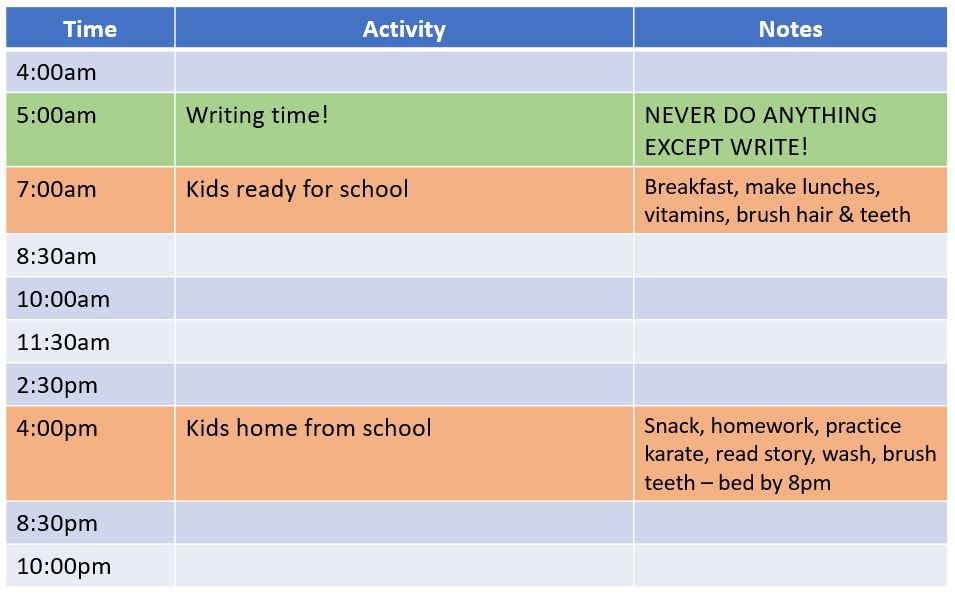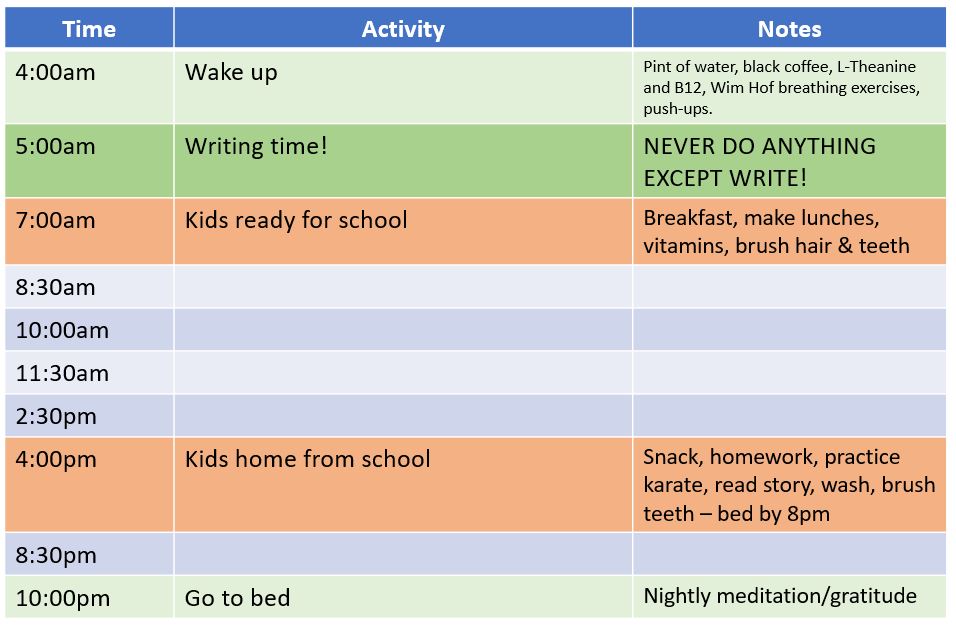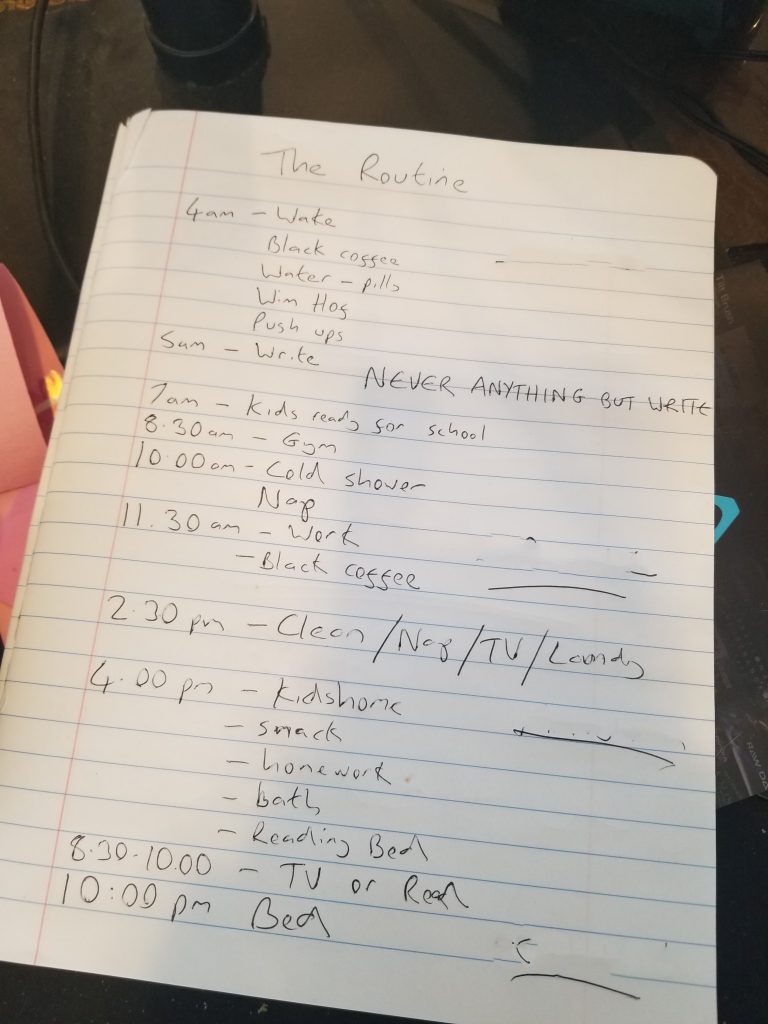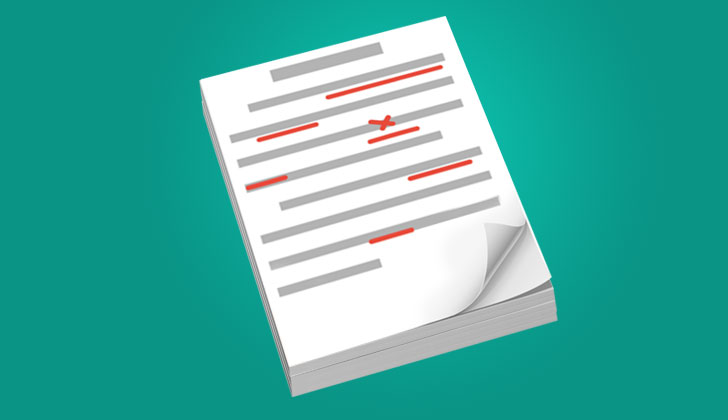Write Your Routine
Ginger has been hitting us hardcore with posts about overcoming the tangible obstacles that keep us from writing. The most important thing he’s discussed is the idea of creating a routine and then sticking to it. But what does such a routine look like, and how do you create one? Today, Ginger gives us those details by walking us through the real-life example of his own daily routine, how he came up with it, and the steps you can use to write your own.
Craving a daily routine? Just create one!
I’ve received a couple of messages since posting my series about Overcoming the Obstacles to Writing asking why I decided to hone in on that topic – since it rung true for a lot of authors. The truth is because it’s a challenge that I continue to struggle with, and it was useful to share some of the tactics and strategies that had worked for me.
When I read Daily Rituals, one of the things that really struck me was how important routine was – with many of the creative people featured describing how routine freed their mind from mundane decisions and helped them get into the ‘flow’ faster. My biggest challenge was that routine – since I have three unpredictable kids and a wife who some describe as “a force of nature” and others as “an angel of chaos.”
I never seemed to have enough time to get things done, I was always finding myself playing ‘catch up’ and my writing was – without fail – the first thing that got knocked off the ‘to do’ list in preference of something more urgent. Since writing is what pays the bills… Well, it wasn’t a good situation to be in.
But the solution ended up being far, far more straightforward than I could have possibly imagined…
I was desperately seeking some routine in my life… So, I just wrote one.
It was literally as simple – and breathtakingly effective – as that.
The key is understanding a grim but firm truth – some things aren’t going to change; so build your routine around them.
For me, it was balancing being a stay-at-home father with getting the work done that would pay the mortgage! I wound myself up in knots with frustration when I was trying to write, and the kids would come down for their morning routine. It was difficult to tear myself away mid-flow and almost impossible to return to it afterward…
…but it had to be done.
It had to be done.
But by sitting down and writing out a routine… it got easier. I embraced the inevitable, and stopped wasting time by getting frustrated about it.
How to Create your Daily Routine
A good starting point is to imagine your day, stretching out ahead of you like a blank sheet of paper, and filling it in as you would if it was a ‘perfect’ day; while at the same time including all the real-life responsibilities that you have to manage.
For me, that included time to write… but also go to the gym, and balance my marketing and blogging and other projects. Not to mention keeping up with my reading!
I started off by creating a blank sheet and listing some useful or noteworthy times to the left of it.

Then I filled in the slots in which I knew I wouldn’t be able to write or work, because of the kids.

As you can see, these time slots are marked in fiery amber – dictating to myself that I will not try to multitask. My writing suffers… My kids suffer… No, I want to dedicate writing and working time to writing and working, and try and be ‘in the moment’ when the kids are home.
Next, I wanted to put in the most important part of my day: Writing.
(Okay, probably keeping the kids alive and fed is more important, but…)
This is a KEY step, because the biggest problem with trying to ‘wing it’ without a routine is that writing is always the first activity to get shelved, and yet it’s the most important activity. You are a writer, after all. So, be brutal and dictatorial about scheduling time every day to write!
I’m personally an early riser, so I know I can get some solid writing done every morning before the kids get up.

Notice the most important part here, in all caps: NEVER DO ANYTHING EXCEPT WRITE.
I mean this. You should mean this too! Dedicate your writing time to writing and nothing except writing. This is a firm rule for a number of reasons. It sets your brain into a routine, so like Pavlov’s dog, you become conditioned to write at this time. It also ensures that you make progress each and every day – and 1,000 words a day for a week is better than a single day writing 5,000 words; and more sustainable.
However, in order to make this work, you need to grudgingly accept the frailties of the human body. For me, that’s sleep. In order to make this work, you need to establish a time to wake up, and a time to go to bed…
…and stick to it!
Yes, I’m talking to you, Ms. Just-One-More-Episode…
If I aim to get up at 4am, the likelihood is that I won’t sit down in front of my computer until 5am. I’ve factored this in. Likewise, I’ll crash and burn unless I make myself go to bed at 10pm every night. I’ve also included some important routine details to help me get going.

It’s a topic I covered briefly here, but keeping the machinery of your mind and body in peak condition is important. I practice Intermittent Fasting – only eating between the hours of 4pm and 10pm – to help me manage my weight and energy levels. I also take L-Theanine at the same time as black coffee (in combination, a great brain booster) and B12 vitamins for my mood. Finally, I recommend the Wim Hof breathing technique and some form of morning exercises to get the body kick-started.
At night, I get to sleep with the help of two meditation techniques. The first is simply to visualize my perfect life – walking step by step through where I want to be – and the second and more important is to go step-by-step through your memory of that day and acknowledge every good thing that happened to you – everything you have to be grateful for. Trust me, you will never have a bad day if you practice that technique (and you’ll learn to fall asleep before your recollections reach mid-morning!)
Okay, so far, so good. We’ve done the ‘have to do’ section. Now let’s visit the ‘want to do’ section.
Exercise is a really important way to improve your life, and one of my struggles is that the first thing to get sacrificed in the face of chaos was my writing, and the second was going to the gym. Just as I scheduled daily writing time, I did the same for visiting the gym. I also assigned time for an ice-cold shower (this is another thing I learned from that crazy Dutchman Wim Hof, but it really works to boost your energy levels and immune system.)
And by the way, if you get up at 4am there’s no shame in formally assigning time for you to take a nap!

The benefit of this time is that it’s flexible. If I don’t feel like a nap, I’ll just restart things earlier than scheduled.
The next two things on my ‘want to do’ list are to keep the house clean and tidy – I get a real creative boost when I’m in a tidy, organized and peaceful home – and keeping up with my reading (not to mention watching the odd movie or TV show.) So if I schedule time for these activities, I’m more likely to actually do them.

This leaves the final segment – the period between 11:30am and 2:30pm (remember, I don’t eat lunch.) I call this ‘working time’ and the only difference between that and my 5am writing time is that I’m free to work on other projects during this period – the 5am slot is only ever and always dedicated to writing.
So this can be responding to emails, writing blog posts, making videos, working on covers, editing other people’s books. Whatever I need to get done for the day. It’s always good to schedule specific tasks for this period in advance (in this post, I write about methods like Peter Bregman’s 18 Minutes which force you to create a ‘to do’ list for the day to come.) This way you don’t find yourself wondering what to do when you finally get the time to do it!
Just be sure to use this time productively – because time is your most valuable commodity as a writer.

And that’s it! A full daily schedule!
For me, this is a Monday to Friday schedule, and I try to keep the weekends completely focused on the family. Your schedule might be completely different. It doesn’t matter how it differs – whether you write from midnight until sun-up, or in the middle of the day… The only important thing is that you have one!
Seriously – a daily routine or plan like this can make so much difference to your ability to get writing done, keep yourself sane, and balance all of the responsibilities in your life.
How do you stick to it?
The first question I normally get asked after explaining this process is – “Great, Ginger – but how are you meant to stick to this?”
Well, I simply look at this schedule not as a plan, but as a scorecard. I literally tick off each and every box as and when it happens. If I go through a day and I do my pushups, write for two or three hours, accomplish my chores and go to the gym… Well, hooray!
…and if I don’t? I just try again tomorrow.
And I don’t make myself go crazy. If I get invited to a dinner party mid-week, I might have to abandon the reading and 10pm bedtime… for that day only! Likewise, if the kids are home from school, my only consolation is that I wrote from 5am until they got out of bed (which is why you must never compromise on your writing time!)
Be flexible where you have to be, but disciplined when you can. And that’s really the key – being disciplined.
Stick to the routine, do what you’re supposed to be doing at any assigned time, and you’ll be amazed at how much you accomplish.
As I said – I keep score. I try and tick off everything on the list. If I manage that, I go to bed each day with satisfaction – and I rise the following morning with determination.













1 Comments